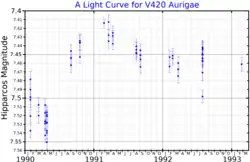| Observation data Epoch J2000 Equinox J2000 | |
|---|---|
| Constellation | Auriga |
| Right ascension | 05h 22m 35.23140s[2] |
| Declination | +37° 40′ 33.6386″[2] |
| Apparent magnitude (V) | 7.35 - 7.51[3] |
| Characteristics | |
| Spectral type | B0IVpe[4] |
| U−B color index | −0.88[5] |
| B−V color index | +0.16[5] |
| Variable type | HMXB[6] + γ Cas[3] |
| Astrometry | |
| Radial velocity (Rv) | −20.5±4.4[7] km/s |
| Proper motion (μ) | RA: +1.305 mas/yr[2] Dec.: −3.999 mas/yr[2] |
| Parallax (π) | 0.7214 ± 0.0196 mas[2] |
| Distance | 4,500 ± 100 ly (1,390 ± 40 pc) |
| Details | |
| HD 34921 A | |
| Mass | 17.5[8] M☉ |
| Radius | 10.8[2] R☉ |
| Luminosity | 1,673[9] L☉ |
| Surface gravity (log g) | 3.5[4] cgs |
| Temperature | 30,000[4] K |
| Metallicity [Fe/H] | −0.39[2] dex |
| Rotational velocity (v sin i) | 240±4[10] km/s |
| Other designations | |
| Database references | |
| SIMBAD | data |
V420 Aurigae is a high-mass star with an inferred compact companion. Closely orbiting each other every 0.8 days, they are a source of X-ray emission.[6]
These coordinates were identified as an X-ray source using the Uhuru satellite in 1978, then associated with the star V420 Aurigae by V. F. Polcaro and associates in 1984.[12] The spectrum of the star shows rapid variation in the lines of singly-ionized iron and Balmer line emission, with these varying on a time scale of less than 300 seconds. This lends support to the presence of a compact companion.[13] The system displays an infrared excess, suggesting it has an orbiting circumstellar envelope of gas and possibly dust.[4] The system appears to be positioned at the center of an irregular, wispy nebula that was detected in the infrared band. One of the two filaments in this nebula appears to be connected with the system.[12]
References
- ↑ "/ftp/cats/more/HIP/cdroms/cats". Centre de Données astronomiques de Strasbourg. Strasbourg astronomical Data Center. Retrieved 15 October 2022.
- 1 2 3 4 5 6 7 Vallenari, A.; et al. (Gaia collaboration) (2023). "Gaia Data Release 3. Summary of the content and survey properties". Astronomy and Astrophysics. 674: A1. arXiv:2208.00211. Bibcode:2023A&A...674A...1G. doi:10.1051/0004-6361/202243940. S2CID 244398875. Gaia DR3 record for this source at VizieR.
- 1 2 V420 Aurigae, AAVSO, retrieved 2022-06-12
- 1 2 3 4 Polcaro, V. F.; et al. (May 1990), "BD +37 1160 : a probable optical counterpart of the X-ray source 1H 0521+373", Astronomy and Astrophysics, 231: 354–364, Bibcode:1990A&A...231..354P.
- 1 2 Lutz, J. H.; Lutz, T. E. (June 1972), "UBV and Hgamma observations of early-type field stars", Astronomical Journal, 77: 376, Bibcode:1972AJ.....77..376L, doi:10.1086/111296.
- 1 2 Percy, John R.; et al. (February 2004), "Short-Period Variable Be Stars Discovered or Confirmed through Self-Correlation Analysis of Hipparcos Epoch Photometry", The Publications of the Astronomical Society of the Pacific, 116 (816): 178–183, Bibcode:2004PASP..116..178P, doi:10.1086/382246, S2CID 120898311.
- ↑ Gontcharov, G. A. (November 2006), "Pulkovo Compilation of Radial Velocities for 35,495 Hipparcos stars in a common system", Astronomy Letters, 32 (11): 759–771, arXiv:1606.08053, Bibcode:2006AstL...32..759G, doi:10.1134/S1063773706110065, S2CID 119231169.
- ↑ Fortin, Francis; García, Federico; Chaty, Sylvain; Chassande-Mottin, Eric; Simaz Bunzel, Adolfo (2022), "Constraints to neutron-star kicks in high-mass X-ray binaries with Gaia EDR3", Astronomy and Astrophysics, 665: A31, arXiv:2206.03904, Bibcode:2022A&A...665A..31F, doi:10.1051/0004-6361/202140853, S2CID 249461983.
- ↑ Brown, A. G. A.; et al. (Gaia collaboration) (August 2018). "Gaia Data Release 2: Summary of the contents and survey properties". Astronomy & Astrophysics. 616. A1. arXiv:1804.09365. Bibcode:2018A&A...616A...1G. doi:10.1051/0004-6361/201833051. Gaia DR2 record for this source at VizieR.
- ↑ Halbedel, Elaine M. (September 1996), "Rotational Velocity Determinations for 164 Be and B Stars", Publications of the Astronomical Society of the Pacific, 108: 833, Bibcode:1996PASP..108..833H, doi:10.1086/133804, S2CID 119944672.
- ↑ "HD 34921". SIMBAD. Centre de données astronomiques de Strasbourg. Retrieved 2021-11-10.
- 1 2 Prišegen, M. (January 2019), "Concerning the occurrence of bow shocks around high-mass X-ray binaries", Astronomy & Astrophysics, 621: 12, arXiv:1811.06781, Bibcode:2019A&A...621A..37P, doi:10.1051/0004-6361/201832682, S2CID 119443071, A37.
- ↑ Rossi, C.; et al. (September 1991), "Rapid variability of BD +37 1160, a possible optical counterpart of the X-ray source 1H 0521+373.", Astronomy and Astrophysics, 249: L19, Bibcode:1991A&A...249L..19R.
Further reading
- Norci, L.; et al. (December 2006), "Is the X-ray Transient HD 34921 (4U 0515+38) a B[e] Star?", Stars with the B[e] Phenomenon. ASP Conference Series, Vol. 355, Proceedings of the Conference Held 10-16 July, 2005, at the Isle of Vlieland, The Netherlands, San Francisco: Astronomical Society of the Pacific, vol. 355, p. 289, Bibcode:2006ASPC..355..289N.
- Polcaro, V. F.; et al. (2007), St.-Louis, Nicole; Moffat, Anthony F.J. (eds.), "The Very Unusual HMXRB HD 34921", Massive Stars in Interactive Binaries, ASP Conference Series 367, San Francisco: Astronomical Society of the Pacific, vol. 367, p. 471, Bibcode:2007ASPC..367..471P.
- Waagen, Elizabeth O. (October 2016), "Observations of V420 Aur (HD 34921) needed to support spectroscopy", AAVSO Alert Notice 554, vol. 554, p. 1, Bibcode:2016AAN...554....1W.
- Polcaro, V. F.; et al. (2006), Meurs, E. J. A.; Fabbiano, G. (eds.), "The Be/X-ray transient HD34921", Populations of High Energy Sources in Galaxies Proceedings of the 230th Symposium of the International Astronomical Union, Held in Dublin, Ireland 15-19 August 2005, Cambridge: Cambridge University Press, vol. 1, pp. 49–50, Bibcode:2006IAUS..230...49P, doi:10.1017/S1743921306007824.
